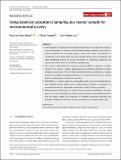Files in this item
Using balanced acceptance sampling as a master sample for environmental surveys
Item metadata
| dc.contributor.author | Van Dam-Bates, Paul | |
| dc.contributor.author | Gansell, Oliver | |
| dc.contributor.author | Robertson, Blair | |
| dc.date.accessioned | 2019-06-19T16:30:02Z | |
| dc.date.available | 2019-06-19T16:30:02Z | |
| dc.date.issued | 2018-07 | |
| dc.identifier | 259356541 | |
| dc.identifier | ddd207bb-ea4c-4135-835b-ee9105bf8fc5 | |
| dc.identifier | 85045287269 | |
| dc.identifier.citation | Van Dam-Bates , P , Gansell , O & Robertson , B 2018 , ' Using balanced acceptance sampling as a master sample for environmental surveys ' , Methods in Ecology and Evolution , vol. 9 , no. 7 , pp. 1718-1726 . https://doi.org/10.1111/2041-210X.13003 | en |
| dc.identifier.issn | 2041-210X | |
| dc.identifier.uri | https://hdl.handle.net/10023/17929 | |
| dc.description | Funding: This research was funded b the Department of Conservation in New Zealand. | en |
| dc.description.abstract | 1. Well‐designed environmental monitoring programmes for management organisations are important for evidence‐based decision making. However, many environmental problems are not single agency issues that require intervention or monitoring at one spatial scale. A master sample can be used to coordinate and scale monitoring designs to ensure consistency in information gathered and robustness of estimators at the different spatial scales. 2. We propose using balanced acceptance sampling (BAS) to generate a master sample. In this context, practical applications and justification of BAS as a master sample are addressed. These include sample generation, stratification, unequal probability sampling, rotating panel designs, and regional intensification. A method for incorporating legacy sites is also provided. 3. Using BAS as a master sample is conceptually simple, gives good spatial balance over different spatial scales, and is computationally efficient to generate. An example for terrestrial biodiversity monitoring in New Zealand is provided. 4. Environmental monitoring can benefit from increased coordination between agencies. A master sample is an excellent way to incorporate coordination directly into the sample design. BAS improves on methods previously described and provides an effective method to monitor populations at multiple spatial scales. | |
| dc.format.extent | 987530 | |
| dc.language.iso | eng | |
| dc.relation.ispartof | Methods in Ecology and Evolution | en |
| dc.subject | Environmental monitoring | en |
| dc.subject | Legacy monitoring | en |
| dc.subject | Master sample | en |
| dc.subject | Spatial balance | en |
| dc.subject | GE Environmental Sciences | en |
| dc.subject | QA Mathematics | en |
| dc.subject | DAS | en |
| dc.subject | SDG 15 - Life on Land | en |
| dc.subject.lcc | GE | en |
| dc.subject.lcc | QA | en |
| dc.title | Using balanced acceptance sampling as a master sample for environmental surveys | en |
| dc.type | Journal article | en |
| dc.contributor.institution | University of St Andrews. Statistics | en |
| dc.identifier.doi | 10.1111/2041-210X.13003 | |
| dc.description.status | Peer reviewed | en |
This item appears in the following Collection(s)
Items in the St Andrews Research Repository are protected by copyright, with all rights reserved, unless otherwise indicated.

